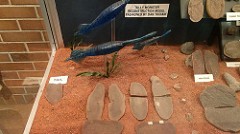By Staff Reporter, | February 22, 2017

Tully Monster Fossils
Tullimonstrum, colloquially known as the Tully Monster, is an extinct genus of soft-bodied bilaterian that lived in shallow tropical coastal waters of muddy estuaries during the Pennsylvanian geological period, about 300 million years ago.
Like Us on Facebook
The Tully Monster, an oddly configured sea creature with teeth at the end of a narrow, trunk-like extension of its head and eyes that perch on either side of a long, rigid bar, has finally been identified. Tully monster (Tullimonstrum gregarium) was likely an invertebrate a spineless beast, researchers said in the new study.
The #Tully Monster (#Tullimonstrum gregarium) is a vertebrate!: https://t.co/MVJxc3fQmA pic.twitter.com/Pj7Icp9qVz
— Nobu Tamura (@paleofan) March 20, 2016
For decades, the Tully Monster has been one of the great fossil enigmas: It was discovered in 1958, first described scientifically in 1966, yet never definitively identified even to the level of phylum (that is, to one of the major groups of animals). Officially known as Tullimonstrum gregarium, it is named after Francis Tully, the amateur fossil hunter who came across it in coal mining pits in northeastern Illinois.
Tullimonstrum Gregarium. pic.twitter.com/dr4GMDGak0 — Tully Bloom (@tullybloom) April 20, 2016
In the other study, published in April 2016 in the journal Nature, scientists used a scanning electron microscope to show that the monster's eyes held melanosomes - structures that produce and store melanin. These complex tissues indicated that the creature was likely a vertebrate, the researchers of that study said.
Having this kind of misassignment really affects our understanding of vertebrate evolution and vertebrate diversity at this given time," Researcher said" There are plenty of weird things, and that's great, if you're going to make extraordinary claims, you need extraordinary evidence.
-
Use of Coronavirus Pandemic Drones Raises Privacy Concerns: Drones Spread Fear, Local Officials Say

-
Coronavirus Hampers The Delivery Of Lockheed Martin F-35 Stealth Fighters For 2020

-
Instagram Speeds Up Plans to Add Account Memorialization Feature Due to COVID-19 Deaths

-
NASA: Perseverance Plans to Bring 'Mars Rock' to Earth in 2031

-
600 Dead And 3,000 In The Hospital as Iranians Believed Drinking High-Concentrations of Alcohol Can Cure The Coronavirus

-
600 Dead And 3,000 In The Hospital as Iranians Believed Drinking High-Concentrations of Alcohol Can Cure The Coronavirus

-
COVID-19: Doctors, Nurses Use Virtual Reality to Learn New Skills in Treating Coronavirus Patients







